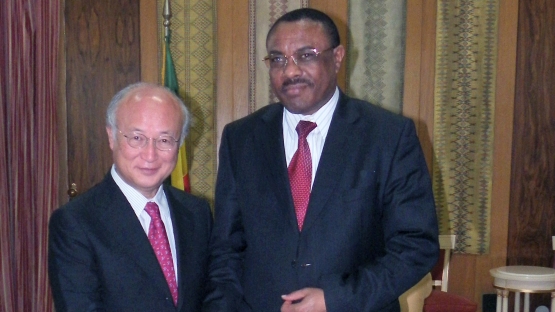In Addis Ababa, IAEA Director General Yukiya Amano continued his two-day official visit to Ethiopia on 13 November 2012 and met Prime Minister Hailemariam Desalegn.
In their meeting, the Director General and the Prime Minister discussed progress made by the Southern Tsetse Eradication Project (STEP) project and they both expressed their commitment to ensuring the success of the project.
The Prime Minister expressed his thanks for the IAEA's assistance in the areas of cancer treatment, water management and in the uses of other nuclear applications. The Prime Minister noted the impact of climate change on Africa and how Agency projects can help in coping with climate change.
The Director General briefed the Prime Minister on plans for an IAEA cancer training centre at Seibersdorf, Austria. He also provided the Prime Minister an overview of the IAEA's progress in implementing the Action Plan on Nuclear Safety, adopted following the Fukushima accident, as well as the prospects for nuclear energy in the future.
In Kaliti, Ethiopia, the Director General also visited the STEP Tsetse Rearing and Irradiation Facility accompanied by the Ethiopian Minister for Science and Technology, Dessie Dalkie, and the African Union Commissioner for Rural Economy and Agriculture, Tumusiime Rhoda Peace.
At the facility, the Director General received a briefing on the project's progress and viewed the tsetse rearing and irradiation facilities. Experts also provided a summary of the effects of the first sterile fly releases in southern Ethiopia.
Background
Southern Tsetse Eradication Project (STEP)
The main IAEA intervention in insect and pest control programme in Africa is the integration of the Sterile Insect Technique (SIT) in the context of area-wide integrated pest management (IPM). Male flies are mass produced in insect factories, sterilized by radiation and released into the wild, where they mate with wild virgin female flies. Because the males are sterile, there are no offspring, and the life cycle of the tsetse fly is interrupted. This technique does not leave any chemical residue, nor are the sterile male flies radioactive. The aim is to create tsetse-free zones in selected areas. Tsetse flies have been successfully eradicated from Zanzibar using this technique.
The IAEA has been providing support to the Southern Tsetse Eradication Project (STEP) for the last 14 years. This large, complex project aims to create a zone free of tsetse and trypanosomosis in an area measuring 25 000 km2 in the Ethiopian Southern Rift Valley by developing and applying area-wide integrated pest management, involving an SIT component. The project has completed baseline data collection and feasibility assessment, and is currently in the pre-operational and capacity building phase. The large mass-rearing and irradiation centre facility in Ethiopia is operating effectively, and in April this year, the first weekly aerial releases of male flies were initiated in the Deme Basin.
Technical Cooperation Projects
The IAEA develops and transfers nuclear technology to Member States through coordinated research activities, the sharing of good practices, and technical cooperation projects that support sustainable socioeconomic development.


